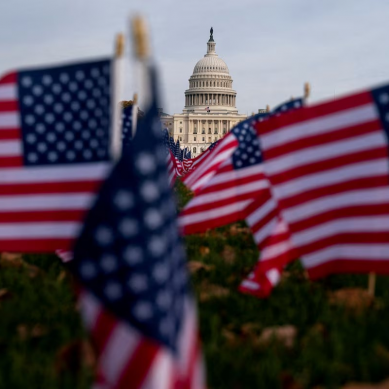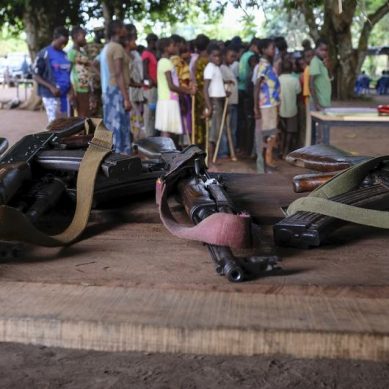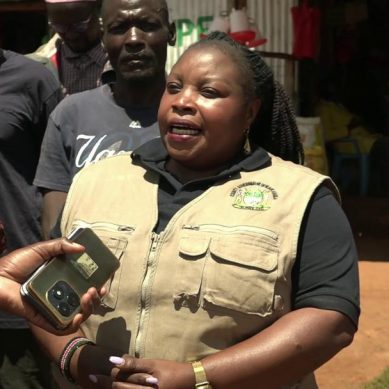
Kenya’s inventory of armoured vehicles continues to grow, with the country recently taking into service new DCD Springbuck armoured personnel carriers (APCs) from South Africa and second-hand M1117 armoured security vehicles from the United States.
The acquisition come on the back of political protests and rising incidents of terrorism that seemed to stretch Kenya’s capacity to fend off external threats as well as quell violent demonstrations at home.
In early February this year, a large convoy was seen transporting Springbuck armoured vehicles to the capital Nairobi ahead of formal commissioning on March 6 by the ministry of interior.
The vehicles were commissioned by Interior Cabinet Secretary Onesimus Kipchumba Murkomen at the General Service Unit (GSU) Headquarters in Ruaraka, Nairobi. At least half a dozen Springbucks were seen at the ceremony. Murkomen said the vehicles were part of the government’s modernisation agenda that has seen a major drop in criminal activity, particularly in the northern parts of the country, where banditry has dropped by 70 per cent. The new vehicles will be deployed to address cattle rustling, banditry and terrorism.
The vehicles acquired are Springbuck Standard Duty (SD) models. The 4×4 SD has B6 ballistic protection (up to 7.62×51 mm rounds) and can withstand a TM57 landmine directly under the hull, or two under any wheel. The SD is the lightest in the series and weighs 9,000 kilogrammes and has a 1,500 kilgrammes payload. It is powered by the MWM 6.10T 6.45 litre six cylinder turbocharged diesel delivering 194 horsepower.
The Springbuck HD is powered by an MWM 6.12TCA 7.2 litre six cylinder turbocharged diesel engine delivering 286 horsepower and giving a maximum speed of 110 kilometres per hour and range of 600 km. The 13 000 kg vehicle has a payload of 2 500 kg and B7 ballistic protection (up to 30.06 armour piercing rounds).
Kenya’s military has been operating the Springbuck for at least five years with several surviving improvised explosive device (IED) hits in operations along the border with Somalia. In 2019, DCD said it was manufacturing a new batch of Springbuck SD (Standard Duty) and HD (Heavy Duty) vehicles for East and West African customers, but provided no further details. Official Kenyan confirmation of Springbuck operation came in March 2024 when the ministry of interior commissioned equipment for an internal security operation, including eight Springbuck APCs.
Also this year, the first M1117 Guardian APCS being provided by the United States were spotted driving on Kenyan roads, with videos emerging in June of at least half a dozen driving in convoys.
In mid-2024, the US revealed plans to transfer eight UH-1 ‘Huey’ and eight MD500 helicopters to Kenya along with roughly 150 M1117 armoured vehicles to improve regional security following a historic visit by Kenyan President William Ruto to the United States. Equipment deliveries were due between late 2024 and mid-2025 to bolster Kenya’s ability to provide regional peace and security and participate in peacekeeping missions.
The M1117 vehicles are from US Excess Defence Article stocks. The Massachusetts National Guard, through the State Partnership Programme (SPP), is helping Kenya with M1117 refurbishment and training. This is a collaboration between the Kenya Army Corps of Electrical and Mechanical Engineering (KACEME) and the Massachusetts National Guard.
A team of maintenance experts from the Massachusetts National Guard exchanged best practices on the M1117 with members of the KACEME at the Kahawa Barracks in Kenya in late May this year. “For the Kenya Defence Forces, the refurbished vehicles will serve as a critical component of their mounted infantry operations. For the Massachusetts National Guard, the mission enhanced their innovation and critical thinking skills, finding creative solutions to resource constraints while adapting to a work environment different from the maintenance US facilities they are familiar with,” the Massachusetts National Guard said in June.
In noted the Kenya Defence Forces acquired 144 M1117s from the US last year. “Massachusetts National Guard soldiers previously operated and maintained the vehicle during military police operations and agreed to partner with Kenya to refurbish the newly acquired fleet. Once restored, the vehicles are expected to be deployed to the Kenya-Somalia border for counterterrorism operations alongside US forces.”
“In November 2024, the Massachusetts National Guard team conducted an initial two-week site visit to perform inventory checks, inspections and fault assessments. During their return in May, they addressed the identified capability gaps and supported advanced maintenance operations such as weapons configuration, bore-sighting, depth recovery setup and removal of power packs and turrets. The team also helped KDF take measurements to begin fabricating tools for turret stands, power-pack stands and lifting brackets,” the National Guard said.
The M1117 armoured security vehicle (ASV), also known as the Guardian, was developed by Textron Marine and Land Systems’ (TM&L) Cadillac Gage. It was first introduced into the US Army’s Military Police inventory in 1999 with several thousand subsequently manufactured for the US. Operation Iraqi Freedom and Operation Enduring Freedom were the two major missions in which the vehicle was involved as mission essential equipment.
The infantry carrier vehicle can accommodate two crew and eight passengers. The M1117 comes with a 40mm MK-19 grenade launcher and a 12.7mm machine gun. It is protected against anti-tank mines and ballistic threats. The M1117 is powered by a 260 horsepower Cummins 6CTA8.3 diesel engine coupled with an Allison MD3560 six-speed transmission, giving a top speed of over 100 km/h.
In July last year, Kenya received the first two of the eight UH-1 helicopters pledged. Besides increasing Kenya’s capacity to provide regional peacekeeping support and participate in security operations, the helicopters will be used in air assaults to deploy and evacuate troops and to deliver supplies.
Since 2020, the US has allocated $230 million in civilian security and defence sector funding to Kenya, including ongoing advisory and training assistance from the Massachusetts National Guard that benefits Kenyan pilots, logistics personnel and the KDF’s Disaster Response Battalion.
Last year the US designated Kenya a key non-NATO ally but that status is now in jeopardy. On August 1, US Senate Foreign Relations Committee Chairman Jim Risch introduced a suite of legislative amendments, including a call for review of Kenya’s designation as a major non-NATO ally.
Under the amendment, the US President must submit a report to Congress evaluating whether Kenya’s policies remain aligned with US national security goals. This assessment is expected to scrutinise not only Kenya’s bilateral military cooperation with the United States but also its growing entanglements with China and Russia.
- A Tell Media report








